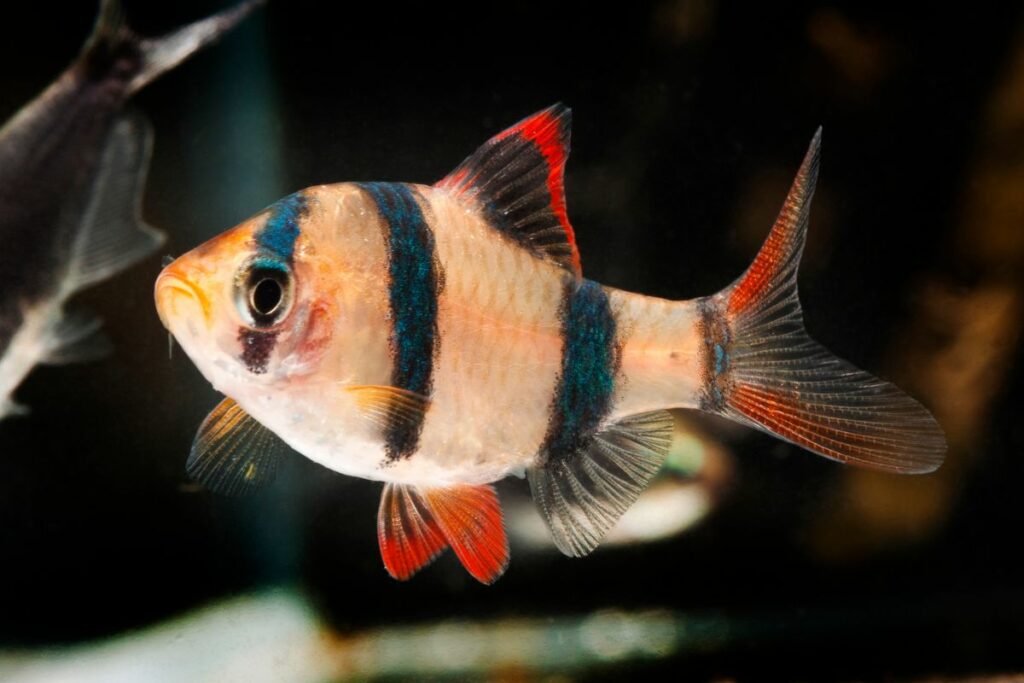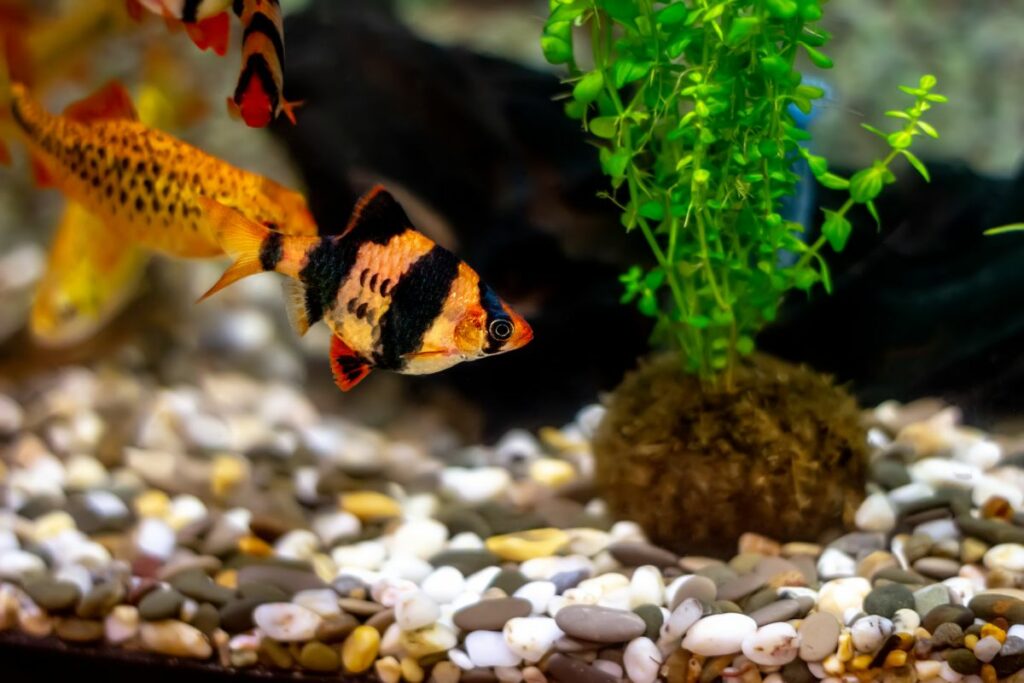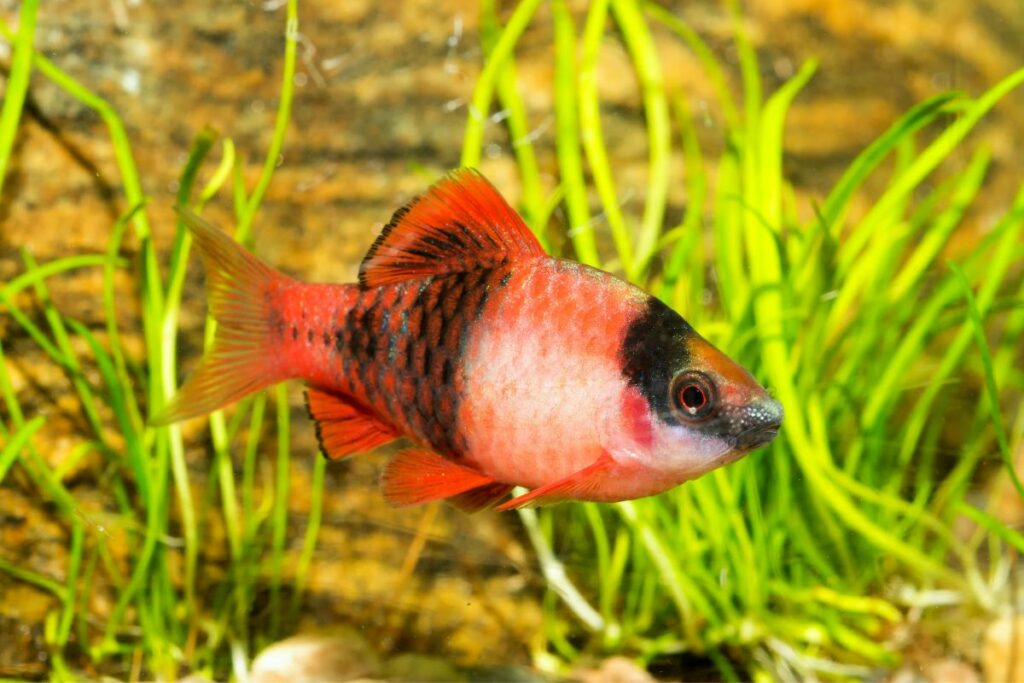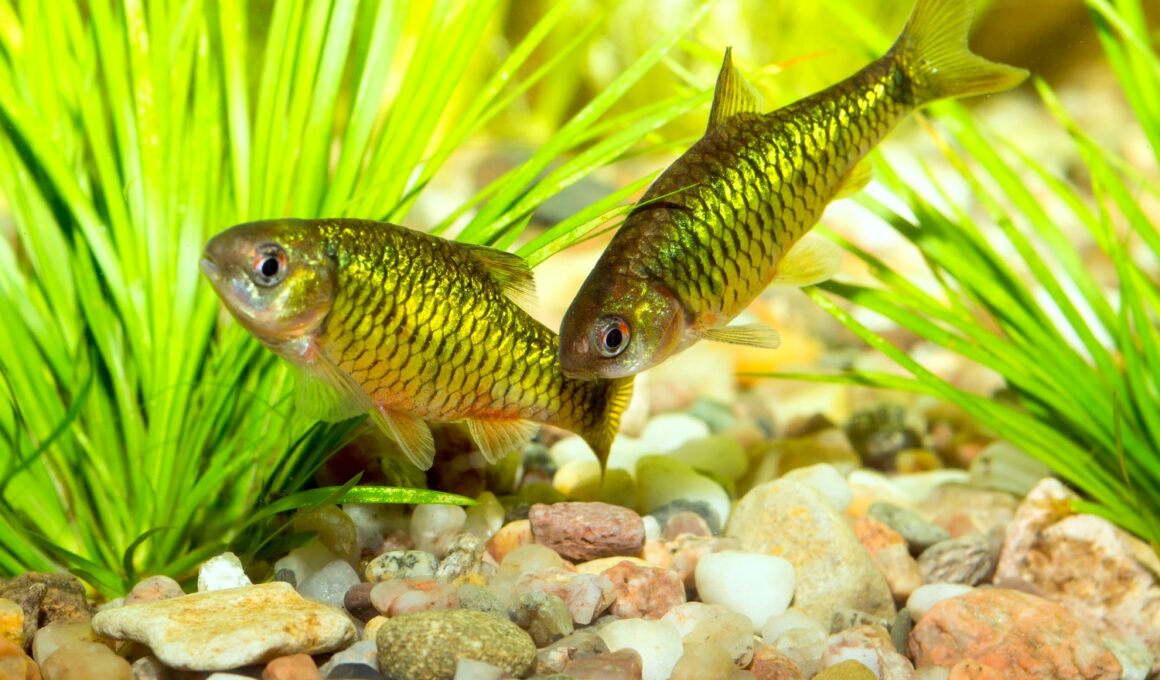In this article Show
If you’re reading this, you’re likely interested in the colorful and lively world of barbfish. These little swimmers have charmed their way into many aquariums for good reason.
Not only are they vibrant and active, but they also adapt well to a variety of settings, making them ideal for both newcomers and seasoned fishkeepers alike. But let’s be clear: keeping barbs happy and healthy requires more than just a sprinkle of fish food and a periodic water change.
That’s why I’ve put together this comprehensive guide to cover everything you need to know about barb fish care—from setting up the ideal tank to what to feed them and how to maximize their lifespan.
So, whether you’re planning to add some barbs to your aquatic family or already have a few swimming around, this guide has got you covered. Let’s get started!

Types of Barbs Fish
When it comes to barbs, you’ve got options—plenty of them. From the vivid Cherry Barb to the feisty Tiger Barb, there’s a type to suit nearly any aquarist’s taste. Let’s explore some of the most popular types of barbs that you can consider adding to your tank:
1. Cherry Barbs
These are among the most peaceful barbs you can find. Cherry Barbs feature vibrant red colors, especially the males, which intensify during mating periods. They’re a great choice for community tanks, cohabiting well with other peaceful fish.
- Tank Size: 20 gallons or more
- Diet: Omnivore
- Water Parameters: pH 6.0-8.0; 22-27°C (72-81°F)
2. Tiger Barbs
If you’re looking for something a bit more energetic, meet the Tiger Barb. Characterized by their bold black stripes and bright orange or yellow bodies, Tiger Barbs bring a lot of activity to any tank. However, they can be somewhat nippy and may not be the best choice for a tank with slow-moving or long-finned fish.
- Tank Size: 30 gallons or more
- Diet: Omnivore
- Water Parameters: pH 6.0-7.0; 22-26°C (72-79°F)
3. Tinfoil Barbs
These are the big boys of the barb world, capable of growing up to 14 inches! Tinfoil Barbs are named for their shiny, silver appearance, almost like tin foil. They’re peaceful but due to their size, they require a much larger tank.
- Tank Size: 75 gallons or more
- Diet: Omnivore
- Water Parameters: pH 6.5-7.5; 22-25°C (72-77°F)
4. Gold Barbs
As their name suggests, Gold Barbs feature a beautiful gold coloration. They are hardy and adapt well to a variety of water conditions, making them excellent for beginners. Like Cherry Barbs, they’re quite peaceful and get along well with other community fish.
- Tank Size: 20 gallons or more
- Diet: Omnivore
- Water Parameters: pH 6.0-8.0; 18-24°C (64-75°F)
Each type of barb has its unique requirements and characteristics, so be sure to pick the one that matches your skill level, tank size, and the kind of community you wish to build.
Natural Habitat For Barb Fish
Understanding the natural habitat of barbs is essential for mimicking those conditions in your home aquarium. This not only ensures their well-being but also makes for a more natural and visually pleasing setup.
1. Rivers, Streams, and Lakes
Barbs are predominantly freshwater fish found in various types of water bodies across Asia and Africa. Depending on the species, you can find them in slow-moving rivers, fast-flowing streams, and even in calm, tranquil lakes.
Some types, like the Tiger Barb, often inhabit densely vegetated waters, which offer both food and protection.
2. Water Conditions
The water conditions in these habitats vary but generally speaking, barbs are used to:
- Temperature: Ranging from 18-28°C (64-82°F), depending on the species.
- pH Level: Typically, a slightly acidic to neutral pH range of 6.0-7.5 is common in their natural habitats.
- Water Hardness: They usually live in soft to moderately hard water, with some species being more adaptable to varying degrees of hardness.
3. Habitat Complexity
In the wild, barbs enjoy a complex environment full of plants, rocks, and driftwood, which serves as hiding spots from predators and breeding grounds. The water is often clear but can be slightly tannin-stained due to decaying organic matter, giving it a somewhat tea-colored appearance.
Understanding the natural habitat of your chosen barb species will guide you in setting up your tank to make it as homely as possible for these finned friends.
Tank Setup
Getting the tank setup right is more than half the battle in fishkeeping. You want to create an environment that not only looks good but also meets the physical and psychological needs of your barbs. Let’s break down the key components of a successful tank setup for these colorful swimmers.
1. Recommended Tank Size
The tank size largely depends on the type of barb you choose. As a rule of thumb:
- Cherry and Gold Barbs: At least a 20-gallon tank
- Tiger Barbs: A 30-gallon tank or larger to accommodate their active swimming
- Tinfoil Barbs: A 75-gallon tank or more, due to their larger size
2. Filtration Systems
A good filtration system is non-negotiable. Barbs are active and generate a fair amount of waste, so you’ll want a filter that can handle both mechanical and biological filtration efficiently. Canister filters and hang-on-back filters are generally good choices.
3. Lighting
Moderate lighting works well for barbs, especially if you plan to have live plants in the tank. LEDs are a popular choice, as they offer good intensity without heating the water much.
4. Substrate
A sandy or fine gravel substrate is ideal, as it mimics the natural riverbeds and lake bottoms where barbs are commonly found. Avoid sharp-edged gravel, as it can injure the fish.
5. Plants and Decorations
Plants not only make the tank aesthetically pleasing but also provide hiding spots for your barbs. Java Fern, Anubias, and Vallisneria are good plant options. Driftwood and rocks can add additional structure and hiding spaces.
Remember, the aim is to mimic the natural habitat of the barb species you keep. The more closely your tank setup resembles their wild environment, the happier and healthier your fish will be.

Water Conditions Suitable For Barbs Fish
So, you’ve got your tank all set up—great! But let’s not forget that the water in that tank needs to meet specific parameters to ensure the well-being of your barbs. After all, even the most beautiful aquarium is only as good as the water quality it maintains. Here’s what you need to know:
1. Ideal Temperature
Most barbs thrive in temperatures between 18-28°C (64-82°F), depending on the species. It’s crucial to have a reliable aquarium heater and thermometer to maintain stable temperatures, especially during winter.
2. pH Level
The ideal pH level for barbs is typically between 6.0 and 7.5. Some species are more adaptable, but it’s generally a good idea to aim for slightly acidic to neutral water. Test the water regularly and use pH adjusters if necessary.
3. Water Hardness
Barbs are usually found in soft to moderately hard water in their natural habitats. Aim for a general hardness (GH) between 4-12 dH. If your water is too hard or too soft, there are various water conditioners available that can help you achieve the correct hardness level.
4. Water Change and Filtration
Regular water changes are key to maintaining these parameters. A weekly 20-25% water change is generally recommended for most barbs, along with regular filter maintenance. Make sure your filtration system is effective enough to handle both mechanical and biological waste.
5. Regular Testing
Regularly test the water for ammonia, nitrites, and nitrates, in addition to pH and hardness. Any spikes in these parameters could be stressful or even fatal to your barbs. Invest in a reliable water test kit and make it a part of your routine.
By maintaining these water conditions, you’re setting the stage for your barbs to not just survive but thrive. It may sound like a lot to manage, but once you get into the rhythm, it becomes second nature.
Diet Requirements
A balanced diet is crucial for the health and longevity of your barbs. Feeding them isn’t complex, but it does require some thought. Knowing what to feed, how much, and when can make all the difference in their health and well-being. Let’s dive in:
1. Omnivorous Diet
Most barbs are omnivores, which means they thrive on a mixed diet of both plant-based and animal-based foods. This is good news for you as an aquarist, as it gives you plenty of options to keep your meals varied and interesting.
2. Commercial Food Options
Pellets and flakes specially formulated for tropical fish are readily available and provide a good nutritional base. These often contain a balanced blend of proteins, fats, vitamins, and minerals.
3. Live or Frozen Foods
For added variety and a protein boost, you can occasionally offer live or frozen foods like bloodworms, brine shrimp, or daphnia. These treats not only fulfill their natural hunting instincts but are also packed with nutrients.
4. Vegetable Matter
Don’t forget the greens! Blanched vegetables like zucchini, cucumber, and spinach can be a healthy addition to their diet. There are also algae wafers and plant-based pellets for those who want a convenient option.
Feeding Frequency and Amount
Adult barbs usually do well with two meals per day. Juveniles, being more active and in a phase of rapid growth, may require three or even four smaller meals. As a rule of thumb, offer only as much food as they can consume in 2-3 minutes to prevent overfeeding.
Overfeeding is a common mistake in fishkeeping. Not only does it lead to obesity and health issues for the fish, but it also fouls the water, putting extra strain on your filtration system.
By offering a balanced and varied diet, you’ll help ensure that your barbs display their brightest colors, maintain optimum health, and live a long, happy life in your aquarium.
Lifespan and Health
When you bring barbs into your aquarium, you’re committing to take care of them for a significant part of their lives. Knowing what to expect in terms of lifespan and potential health issues can help you provide the best care possible for these colorful companions.
1. Lifespan
The lifespan of a barb can vary depending on species, diet, water quality, and overall care. Generally speaking:
- Cherry Barbs: 4-6 years
- Tiger Barbs: 5-7 years
- Tinfoil Barbs: Up to 10 years
- Gold Barbs: 4-6 years
2. Common Health Issues
Like any other fish, barbs are susceptible to certain health issues. Some of the common ailments include:
Ich (Ichthyophthirius multifiliis)
This parasitic infection appears as white spots on the fish’s skin, gills, and fins. Raising the water temperature and using over-the-counter treatments can usually help in the treatment.
Fin Rot
This is often caused by poor water conditions or bacterial infections. Regular water changes and antibiotics can be effective treatments.
Swim Bladder Disease
Symptoms include abnormal swimming patterns and difficulty maintaining buoyancy. This condition is often related to diet, so adjusting food types and amounts can sometimes help.
Preventative Measures
The key to a long and healthy life for your barbs is prevention. Regular water testing, proper filtration, and a balanced diet go a long way in maintaining good health.
Quarantining new fish and plants before adding them to the main tank can also help in preventing the spread of diseases. No fish is entirely immune to health issues, but with proper care and attention, you can maximize the odds of your barbs living a full, healthy life.
Social Behavior and Tank Mates
The social aspect of keeping barbs can be one of the most rewarding experiences for an aquarist. However, it’s essential to understand their behavior and the type of fish they get along with to maintain a peaceful and harmonious tank.
Schooling Fish
Barbs are naturally schooling fish, which means they prefer to be in groups. A minimum group of five is usually recommended, although a larger school will help the fish feel more secure and less stressed. Schooling not only brings out their best colors but also their most natural behaviors.

Compatibility Of Barbs Fish
Barbs generally do well with other fast-moving fish of similar size. However, the compatibility can vary between species.
For example, cherry Barbs are relatively peaceful and can coexist with other mild-mannered fish like tetras and gouramis. Tiger Barbs are known for being a bit nippy and may not be suitable tank mates for slow-moving or long-finned fish.
1. Species to Avoid
Slow-moving fish and those with long fins are generally not the best fit for a barb-dominated tank. Angelfish and bettas, for example, could become targets for nippy barbs.
2. In-Tank Hierarchy
Most barbs establish a sort of “pecking order,” especially when kept in smaller groups. Occasional chasing and nipping are usually harmless but do keep an eye out for signs of bullying or stress, which might require intervention.
3. Tank Division
Consider adding plants, rocks, and driftwood to create natural barriers in the tank. These can act as “safe zones,” helping to reduce stress and territorial disputes among tank mates.
By understanding the social behavior of your barbs and choosing compatible tank mates, you can create a more peaceful and interactive aquarium environment. It adds an extra layer of enjoyment to your fishkeeping experience, watching their social dynamics play out in the underwater world you’ve created for them.
Breeding Your Barb Fish
If you’re interested in taking your fishkeeping hobby to the next level, breeding your barbs can be a rewarding experience. It’s not exceedingly difficult but does require some preparation and close attention. Here’s how to go about it:
1. Sexing the Fish
Identifying the gender of your barbs is the first step in breeding. Male barbs are generally more colorful and slightly smaller. Females are usually rounder, especially when carrying eggs.
2. Setting Up a Breeding Tank
It’s advisable to set up a separate tank for the breeding pair to ensure a controlled environment and easier care of the fry. A 10-20 gallon tank should suffice for most species.
Use a sponge filter to keep the water clean without creating a strong current.
Include some fine-leaved plants or a spawning mop for the female to deposit her eggs.
3. Water Conditions
Maintain a slightly higher temperature, around 2-3°F above the normal range, to encourage spawning. Ensure that the water is soft and slightly acidic to mimic natural breeding conditions.
4. The Breeding Process
- Introduce the Breeding Pair: Place the male and female in the breeding tank.
- Spawning: If conditions are right, the male will chase the female around the tank, culminating in the female laying eggs on the plants or spawning mop. The male will then fertilize them.
- Post-Spawning: Once the eggs are laid and fertilized, it’s usually best to remove the adult fish to prevent them from eating the eggs.
5. Caring for the Fry
Fry will hatch within 2-4 days, depending on the species and water temperature.
Initially, they will feed off their yolk sacs but will soon require infusoria or liquid fry food. Gradually introduce them to baby brine shrimp and crushed flake food as they grow.
By following these guidelines and maintaining close attention to both the breeding pair and the fry, you can successfully breed your barbs and contribute to the next generation of these colorful and engaging fish.
Conclusion
Keeping barbs can be an enriching experience that brings both color and activity to your home aquarium. From tank setup and water conditions to their diet and social behavior, each aspect contributes to the well-being of these vibrant fish.
Whether you’re a beginner or a seasoned aquarist, understanding the specific needs of barbs can lead to a rewarding fishkeeping experience for years to come.






